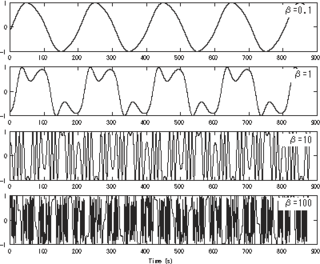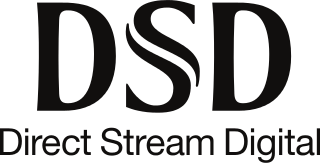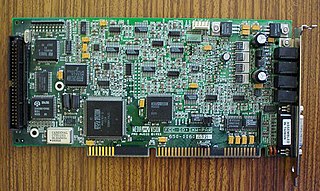This article needs additional citations for verification .(October 2016) |
The digital sound revolution (or digital audio revolution) refers to the widespread adoption of digital audio technology in the computer industry beginning in the 1980s.
This article needs additional citations for verification .(October 2016) |
The digital sound revolution (or digital audio revolution) refers to the widespread adoption of digital audio technology in the computer industry beginning in the 1980s.
Some of the first computer music was created in 1961 by LaFarr Stuart, who wrote software to modulate the duration of and between pulses (pulse-width modulation or "PWM", via a process now often referred to as "bit banging") on a bus line that had been connected to an amplified speaker originally installed to monitor the functioning of Iowa State University's CYCLONE computer, a derivative of the Illiac. The entire computer was used to create simple, recognizable tunes using digital audio.
The speakers in the IBM PC (released in 1981) and its successors may be used to create sounds and music using a similar mechanism.
Programmable sound generators were the first specialized audio circuits in computers included simple analog oscillators that could be set to desired frequencies, generally approximating tones along the musical scale. An example of this is the 1978 POKEY custom ASIC used in the Atari 8-bit family.
The next development was to produce a base frequency, and then modulating it with another frequency to create desired effects; this process of audio waveform synthesis using frequency modulation is usually referred to as FM synthesis. This technology was introduced in the early 1980s by Yamaha, which began manufacturing FM synth boards for Japanese computers such as the NEC PC-8801 and PC-9801 in the early 1980s. This allowed personal computer game audio to have greater complexity than the simplistic beeps from internal speakers. These FM synth boards produced a "warm and pleasant sound" that musicians such as Yuzo Koshiro and Takeshi Abo utilized to produce video game music that is still highly regarded within the chiptune community. [1]
Early integrated circuit devices to incorporate FM synthesis methods include the Yamaha OPL2 chip set (YM3812 and external digital-to-analog converter) was included on the AdLib sound card (1987), on the Creative Technology Sound Blaster (1989), and on the Media Vision Pro AudioSpectrum (1991); these were replaced by the next generation Yamaha OPL3 chip set on the Pro AudioSpectrum 16 and Sound Blaster 16.
As they became more cost-effective, digital-to-analog converter (often called "D-to-A"—abbreviated "D/A", or "DAC") integrated circuits augmented and ultimately replaced FM synthesis devices. These devices enabled computers to play digital audio using an encoding technique known as pulse-code modulation ("PCM"). Unlike pulse-width modulation ("PWM"), which turns a signal on and off, pulse-code modulation also allows the level of a signal to be set to several intermediate levels; in this regard, PWM is similar to black-and-white images, PCM is similar to grayscale images.
Digital audio compact discs (using PCM) were introduced in 1982. Starting in 1985, the medium was adapted for the storage of computer data via the Yellow Book CD-ROM standard and the High Sierra Format (which evolved in ISO 9660).
The Macintosh 128K (1984) and Atari ST (1985) could produce digital audio via software. Without dedicated audio hardware, digital audio on these machines were usually limited to title screens in games (at higher sampling rates) or games which did not feature heavy animation which left enough CPU time to play lower quality samples.
The first computer to with a digital sound processor was the Amiga released in 1985. The MOS Technology 8364 Paula chip has four independent 8-bit DACs and can play either four mono audio channels or two combined stereo channels. It could play digital samples from memory with virtually no CPU usage or any clever software tricks.
In 1989, the Creative Technology Sound Blaster included a processor and digital-to-analog converter, plus the Yamaha OPL2 chip set FM synthesis devices for compatibility with the AdLib sound card. In 1991, Media Vision introduced the original Pro AudioSpectrum, which offered similar functionality but introduced stereo sound, an audio mixer and CD-ROM interface (SCSI and many variants); its 16-bit successor, the Pro AudioSpectrum 16, offered CD-quality sound via its 16-bit compressor-decompressor ("CODEC").
In 1997, Intel created its Audio CODEC standard AC'97, which was superseded in 2004 by Intel High Definition Audio (HD Audio).
High fidelity audio hardware became inexpensive faster than data storage media, driving the development of compression techniques.
A popular early variant of pulse-code modulation ("PCM") was a compressed version called adaptive differential pulse-code modulation ("ADPCM").
Sound module files (originally Amiga .MOD files) enabled music to be created and shared via compact files and played back with high quality (using four channels, each at half the sampling rate of audio compact discs). Soon after the release of its Pro AudioSpectrum 16, Media Vision included with it a MOD file player and sample music files.
In the late 1990s, the MP3 format emerged, allowing music to be stored in relatively small files by using high compressions rates through a predictive synthesis technique. Modern computer CD-ROM drives allowed the Red Book CD-DA data to be read in digital format (versus earlier drives that merely output analog audio), which allows entire volumes of music to be copied and encoded many times faster than normal playback speed.
After the year 2000, strong demand for small portable music players such as Apple's iPods drove competition in component sales, resulting in data storage devices becoming increasingly economical.
The popularity of high-quality compressed music and the widespread availability of Internet access enabled widespread copyright infringement (most notably through Napster) followed by widespread legitimate sales of music online through the Apple iTunes Music Store, Amazon.com, Walmart.com and others.
Until the early 1990s, music was generally recorded and processed by recording studios with the use of analog tape machines, which were essential in recording, editing, mixing and finalizing audio productions. At the beginning of the 1980s, programmable synthesizers and music workstations like the New England Digital Synclavier and the Fairlight CMI appeared, which allowed for parts of a production to be stored digitally within the system's mainframe without the need for audio tape. However, a music production in itself which used such synthesizers usually still involved mixing and editing using analog tape machine equipment.
The first computer applications to offer fully digital tapeless recording, mixing and editing were Cubase and Notator for the Atari ST platform around 1989. In the 1990s, these and similar systems began gaining more ground among recording studios, and as computer processing and storing capacity increased, analog tape equipment was gradually replaced by fully computerized recording, in which every step in the production chain is carried out using software and digital storage.

Frequency modulation synthesis is a form of sound synthesis whereby the frequency of a waveform is changed by modulating its frequency with a modulator. The (instantaneous) frequency of an oscillator is altered in accordance with the amplitude of a modulating signal.

A sound card is an internal expansion card that provides input and output of audio signals to and from a computer under the control of computer programs. The term sound card is also applied to external audio interfaces used for professional audio applications.

Digital audio is a representation of sound recorded in, or converted into, digital form. In digital audio, the sound wave of the audio signal is typically encoded as numerical samples in a continuous sequence. For example, in CD audio, samples are taken 44,100 times per second, each with 16-bit sample depth. Digital audio is also the name for the entire technology of sound recording and reproduction using audio signals that have been encoded in digital form. Following significant advances in digital audio technology during the 1970s and 1980s, it gradually replaced analog audio technology in many areas of audio engineering, record production and telecommunications in the 1990s and 2000s.

Pulse-width modulation (PWM), or pulse-duration modulation (PDM), is a method of controlling the average power delivered by an electrical signal. The average value of voltage fed to the load is controlled by switching the supply between 0 and 100% at a rate faster than it takes the load to change significantly. The longer the switch is on, the higher the total power supplied to the load. Along with maximum power point tracking (MPPT), it is one of the primary methods of reducing the output of solar panels to that which can be utilized by a battery. PWM is particularly suited for running inertial loads such as motors, which are not as easily affected by this discrete switching. The goal of PWM is to control a load; however, the PWM switching frequency must be selected carefully in order to smoothly do so.

Direct Stream Digital (DSD) is a trademark used by Sony and Philips for their system for digitally encoding audio signals for the Super Audio CD (SACD).

The YM2612, a.k.a. OPN2, is a sound chip developed by Yamaha. It is a member of Yamaha's OPN family of FM synthesis chips, and is derived from the YM2203.

A PC speaker is a loudspeaker built into some IBM PC compatible computers. The first IBM Personal Computer, model 5150, employed a standard 2.25 inch magnetic driven (dynamic) speaker. More recent computers use a tiny moving-iron or piezo speaker instead. The speaker allows software and firmware to provide auditory feedback to a user, such as to report a hardware fault. A PC speaker generates waveforms using the programmable interval timer, an Intel 8253 or 8254 chip.

In digital recording, an audio or video signal is converted into a stream of discrete numbers representing the changes over time in air pressure for audio, or chroma and luminance values for video. This number stream is saved to a storage device. To play back a digital recording, the numbers are retrieved and converted back into their original analog audio or video forms so that they can be heard or seen.
A rompler is a synthesizer that plays pre-fabricated sounds based on audio samples. The term rompler is a blend of the terms ROM and sampler. In contrast to samplers, romplers do not record audio. Both may have additional sound editing features, such as layering several waveforms and modulation with ADSR envelopes, filters and LFOs.

Soundscape S-2000 was Ensoniq's first direct foray into the PC sound card market. The card arrived on the market in 1994. It is a full-length ISA digital audio and sample-based synthesis device, equipped with a 2 MiB Ensoniq-built ROM-based patch set. Some OEM versions of the card feature a smaller 1 MiB patch set. It was praised for its then-high quality music synthesis and sound output, high compatibility and good software support.

The Sound Blaster 16 is a series of sound cards by Creative Technology. They are add-on boards for PCs with an ISA or PCI slot.

The Media Vision Pro AudioSpectrum family of personal computer sound cards included the original 8-bit Pro AudioSpectrum (1991), the 8-bit Pro AudioSpectrum Plus, 16-bit Pro AudioSpectrum 16, Pro AudioSpectrum 16 Basic and 16-bit Pro Audio Studio. All PAS cards with the exception of Pro AudioSpectrum 16 Basic could connect to CD-ROM drives—variants having SCSI or various proprietary interfaces—and many were sold in multimedia kits with compatible CD-ROM drives.

In digital audio using pulse-code modulation (PCM), bit depth is the number of bits of information in each sample, and it directly corresponds to the resolution of each sample. Examples of bit depth include Compact Disc Digital Audio, which uses 16 bits per sample, and DVD-Audio and Blu-ray Disc which can support up to 24 bits per sample.
Moonsound is the name of a sound card released for the MSX home-computer system at the Tilburg Computer Fair in 1995. It was designed by electronic engineer Henrik Gilvad and produced by Sunrise Swiss on a semi-hobby basis.
The Yamaha YMF278B, also known as the OPL4, is a sound chip that incorporates both FM synthesis and sample-based synthesis by Yamaha.
Pulse-code modulation (PCM) is a method used to digitally represent sampled analog signals. It is the standard form of digital audio in computers, compact discs, digital telephony and other digital audio applications. In a PCM stream, the amplitude of the analog signal is sampled at uniform intervals, and each sample is quantized to the nearest value within a range of digital steps.

A sound chip is an integrated circuit (chip) designed to produce audio signals through digital, analog or mixed-mode electronics. Sound chips are typically fabricated on metal–oxide–semiconductor (MOS) mixed-signal chips that process audio signals. They normally contain audio components such as oscillators, envelope controllers, samplers, filters, amplifiers, and envelope generators.
The OPL series are a family of sound chips developed by Yamaha. The OPL series are low-cost sound chips providing FM synthesis for use in computing, music and video game applications.